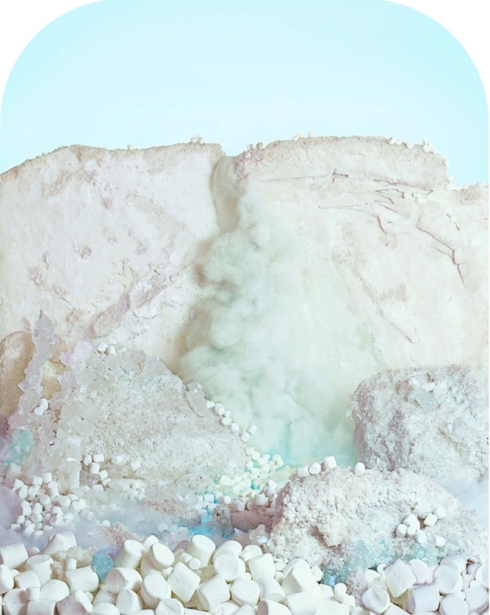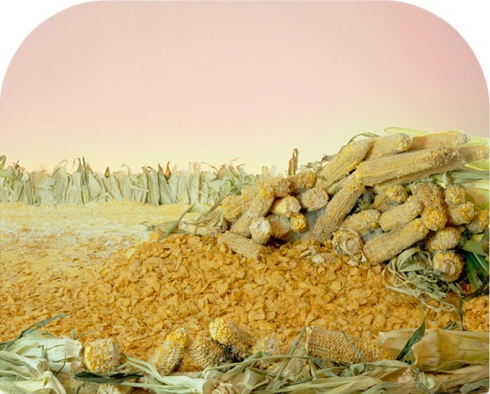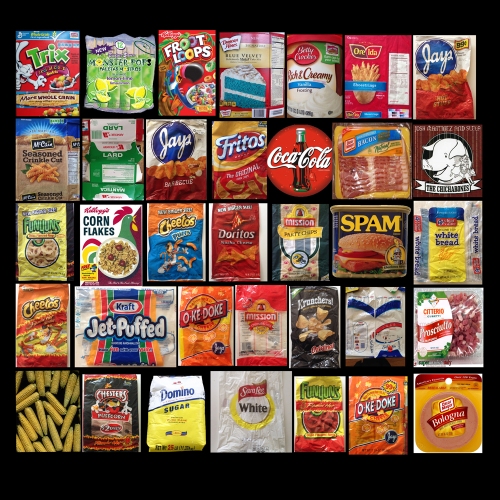You are currently browsing the tag archive for the ‘Ciurej’ tag.
Tag Archive
Sugar-Coated, Corn-Fed Dioramas Query Big-Ag’s Food Production and the Naturalness of Landscape
June 30, 2014 in Fine Art, Historical, Interview | Tags: agribusiness, Carleton Watkins, Ciurej, food, food reproduction, Lindsay Lochman Barbara, Processed Views | by petebrook | 1 comment

Cathedral Rocks – 2600 feet. Yosemite Valley, Mariposa County, California. © Carleton Watkins

White Bread Monument. © Lochman & Ciurej. Ingredients: Soft White Bimboo, Clear Value Round Top White Bread, Roundy’s White Enriched Bread, Roundy’s Sandwich White Enriched, Sarah Lee White Bread.
HISTORY, NATURE AND LANDSCAPE PHOTOGRAPHY
Today, June 30th, marks the 150th anniversary of The Yosemite Grant, signed by Abraham Lincoln, putting the protection of Yosemite Valley into the hands of the state of California with ‘the express conditions that the premises shall be held for public use, resort, and recreation, for all of time. The grant was a precursor to land-use-law that later led to the establishment of the National Parks.
There can be no photographer better known for the early exploration of the American West as Carleton Watkins (1829-1916). Nor is there a mid-to-late 19th century photographer (Ansel Adams did his bit later!) who shaped public opinion about natural spaces as much as Watkins.
What would Watkins say about the RVs that roll into Yosemite and Yellowstone each year? What would Watkins say about the monoculture agribusiness that dominates large swathes of the United States’ land? What would Watkins make of the ubiquity of corn syrup in our diets?
“The series Processed Views interprets the frontier of industrial food production, the seductive and alarming intersection of nature and technology,” write Lindsay Lochman & Barbara Ciurej in their artist statement. As we move further away from the natural sources of our food, we head into uncharted territory replete with unintended consequences for the environment and for our health.”
Processed Views is a witty and painstakingly constructed project that gets at some serious issues. What were Lochman and Ciurej thinking? Exactly how did they piece together these distopic dioramas that drip with E-numbers? Scroll down for our Q&A to find out.

Agassiz Rock and the Yosemite Falls, from Union Point, No. 844, about 1878, Albumen silver print, 54.4 x 39.2 cm, The J. Paul Getty Museum, Los Angeles, 2004.70. © Carleton Watkins.

Red Flamin’ Hot Monolith. © Lochman & Ciurej. Ingredients: Jay’s Barbecue Potato Chips, Fritos Corn Chips, O-ke-doke Cheese Flavored Popcorn, Chester’s Flamin’ Hot Puffcorn, Funyuns Onion Flavored Rings (plain and Flamin’ Hot), Jay’ Hot Stuff Potato Chips, Cheetos Puffs and Flamin’ Hot CrunchyDoritos Nacho Cheese, Mission Party Chips, Krunchers Kettle Cooked Potato Chips, Mission Chicharrones (Pork Rinds).
Q & A
Prison Photography (PP): You’re talking about industrial food production. Is this a concern to you specifically because you are Midwest based?
Lochman & Ciurej (L&C): We built these views to examine consumption, progress and the changing landscape.
As Midwesterners, we have seen the landscape transformed from family farming to agricultural industry. This is not exclusive to the heartland, however, Big Ag and food processing facilities cross the country. In Processed Views: Surveying the Industrial Landscape, we are thinking about trends in consumption, ideas of progress and the changing geography of our country.
We came to Processed Views from an earlier project which addressed the nature of nurturing. In those photographs, we were interested in picturing the emotional and physical energy that flows through the act of preparing and sharing food. We could not ignore, however, the flip-side of food consumption in America: a complex, impersonal system of industrial agriculture, food processing and marketing.
PP: Why use Watkin’s images as the conduit to these issues?
L&C: Watkins’ sublime views framed the American West as a land of endless possibilities and significantly influenced the creation of the first national parks.
However, many of Watkins’ photographs were commissioned by the corporate interests of the day; the Central Pacific Railroad, the Oregon Steam Navigation Company, North Bloomfield Mining and Gravel Company and other lumber and milling interests. His commissions served as both documentation of and advertisement for the American West. Watkins’ images upheld the popular 19th century view of Manifest Destiny – the inevitability of America’s bountiful land, justifiably utilized and consumed by its citizens.

Albion River, 1863. © Carleton Watkins.

Fruit Loops Landscape. © Lochman & Ciurej. Ingredients: General Mills Trix with Fruitalicious Swirls, Kellogg’s Froot Loops.

Marshmallow Chasm. © Lochman & Ciurej. Ingredients: Kraft Jet-Puffed Marshmallows, Kraft Jet-Puffed Miniatures, Trust Classic Pure Mishri Sugar.

Nevada Falls, 700 Ft., Yosemite. © Carleton Watkins.
L&C: June 2014 marks the 150th anniversary of the Yosemite Valley Grant Act, legislation that preserved the land for public use and set a precedent for America’s National Park System.
PP: Given the anniversary, Processed Views was good timing, no?
Stanford’s Cantor Arts Center presents an exhibition Carleton Watkins: The Stanford Albums (April 23–August 17, 2014) in celebration. Tyler Greene recently interviewed curators and scholars, Alexander Nemerov, Erik Steiner and Corey Keller, associated with the exhibition.
PP: You’re fans of Watkins?
L&C: We turn to history and mythology to clarify and anchor our research.
Looking back 150 years, Carleton Watkins iconic photographs honored unsullied nature and documented human behavior on the frontier. They were a revelation at that time. His images record a critical time in the ongoing relationship between industrial development and conservation. We are at another such a moment now and the current discourse is fractured. How can the state of our health, industrial agriculture, chemistry, biological modification of plants and livestock, water and land use, finite natural resources, demographic and geographical change be included in a single conversation?
Referencing Watkins’ sublime views and sites of nascent technological activity in California and Oregon, are an invitation to viewer to consider an alternate reality in which the trajectory of our agricultural production is taken to an extreme. We fast forward to seductive, garish and static monocultures.
We allude to Watkins’ far vista in our tabletop landscapes, hinting at vastness, yet stranding the viewer in a swale of familiar processed food products. The photographer’s 18″ x 22″ Mammoth Plate Views were extraordinarily large and detailed in their time, but are now considered small. We use this format to force the viewer into an intimate encounter with the average American diet. We have oversold our technological commitment to bend the forces of nature in order to fulfill fantasies of a yummy life and heroic expectations of feeding the world. Should we rethink our fun-food utopia?

The Town on the Hill, New Almaden. © Carleton Watkins.

Saturated Fat Foothills. © Lochman & Ciurej. Ingredients: Full Side Pork Chicharrones, Proscuitto Ham.

Castle Rock, Columbia River, 1867. (Alternate Title: Pacific Coast views. No. 1243). © Carleton Watkins.

Deep Fried Bluffs. © Lochman & Ciurej. Ingredients: OreIda shoestrings, McCain Seasoned Crinkle Cut, Armour Lard, Oscar Meyer Bacon.
PP: Were Watkins’ landscapes pure?
L&C: An answer to this question is as vast and deep as Yosemite Valley!
Most recent thought regarding landscape is defined by scholars like Lucy Lippard in The Lure of the Local: Senses of Place in a Multicentered Society. Landscape is not just an aesthetic experience, it must be thought of in terms of community, land use, contemporary perceptions of nature, what is produced on the land and how it shapes the inhabitants through time. Rebecca Solnit’s writing projects Infinite City and Unfathomable City are exquisite examples of this approach.
Tyler Greene discusses Carleton Watkins’ photographs and the transformation of California agriculture a century-and-a-half later in a recent New York Times Lens blogpost.
In the book Print the Legend: Photography and the American West, Martha A. Sandweiss provides a great in-depth discussion of the motivation behind of 19th-century landscape photography.

Cola Sea. © Lochman & Ciurej. Ingredients: Domino Pure Cane Granulated Sugar, Brer Rabbit Molasses, CocaCola, C&H Golden Brown Cane Sugar, C&H Pure Cane Powdered Sugar, Trust Classic Pure Mishri Sugar, Rock Candy.

Sugarloaf Islands at Fisherman’s Bay, Farallon Islands, about 1869, Albumen silver print, 41 x 54.3 cm, The J. Paul Getty Museum, Los Angeles, 85.XM.11.22. © Carleton Watkins.

Monoculture Plains. © Lochman & Ciurej. Ingredients: Corn Flakes, White and Yellow Corn Meal, Corn, Cobs and Husks.

Cape Horn, Columbia River, Oregon, negative, 1867; print by Isaiah West Taber, about 1881-83, Albumen silver print, 40.5 x 52.3 cm, The J. Paul Getty Museum, Los Angeles, 85.XM.11.2. © Carleton Watkins.
PP: What for you are the main concerns about industrial food production?
L&C: Processed Views reflects our concern with current trends in consumption, ideas of progress and the changing geography of our country. All indications are that we are headed into an uncharted, unbalanced, unnatural territory. This terrain is garnished with unintended consequences for our health and for the environment. Why must we thoughtlessly degrade the soil by our technological-agricultural experiments? We must re-evaluate our man-made “utopias”.
PP: Where can we read more on these issues?
L&C: There are striking stories daily, many of them contradictory. We record ideas in our food-based notebook (blog). Recent posts mention books, articles and websites addressing the American diet (Nina Teicholz, Michael Moss, NPR’s The Salt blog) and industrial agriculture: corn production and marketing, meat processing (Christopher Leonard, Maureen Ogle), photography and social history.
PP: Thank you both.
L&C: Thanks, Pete.

A tiled illustrated graphic of the various ingredients used to make Processed Views. © Lindsay Lochman & Barbara Ciurej.
BIOGRAPHY
Barbara Ciurej and Lindsay Lochman began collaborating when they met as students at the Institute of Design in Chicago+Illinois Institute of Technology. Through photographic projects they explore the confluence of history, myth and popular culture. Their photographs have been in numerous solo and group exhibits and are in the collections of the Art Institute of Chicago, the Walker Art Center and the Milwaukee Art Museum.
